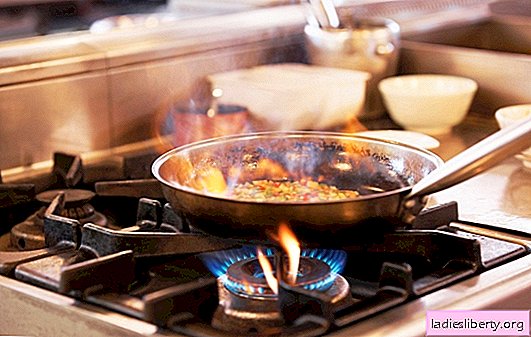
When the pan is heated, soot emits unhealthy fumes, the ingress of harmful substances contained in such a pair increases the risk of cancer.
Deposits and deposits on the outside of the pan are often left unattended. Over time, its layer increases, and the number of unhealthy fumes also increases.
To clean pans from soot, both time-tested and modern methods of cleaning are used.
Carbon pan cleaners
Today it is difficult to dispense with chemical compounds intended for domestic purposes, but they must be used wisely. Remember that not every cleaning agent can be completely washed off with water from the surface of the pan. Mixtures of well-known brands such as Silit, Sanita, Dosya, AOS and Feri do this job well.

If you care about the environment, it is better to use such compounds as Zepter and Amway.
We must not forget that the compositions for cleaning pans are aggressive, and it is extremely important to follow certain rules when working:
1. It is necessary to open a window for ventilation or turn on the hood;
2. Use a respirator;
3. Wear rubber gloves.
Cleaning the pan with folk methods
Cast Iron Frying Pans
It is safe to clean such dishes without using chemical compounds.
- With the help of a blowtorch, the flame is sent to the pan, and they are cleaned until it has cooled, the carbon is removed very easily. It is necessary to perform this operation in the open air, at a distance from people, animals, and flammable buildings.
- A cast iron pan can be cleaned with a sand bath. Pour sand into the pan, and heat it over low heat (taking into account the neglect of the dishes, the heating takes up to 3 hours). Of course, the smell during the operation will not please you, but the carbon deposits will lag behind like burned skin after you tap the pan.
- Cast iron cookware can be cleaned with 3 parts water and 1 share vinegar. The solution is poured into the dishes and heated for 3-4 hours over low heat. It is necessary to ensure that the water does not evaporate. Of course, after such treatment, the pan will start to smell like vinegar. To eliminate this drawback is simple - you need to boil soda with water in a bowl.
- You can grind a pack of activated charcoal tablets and put them in a wet pan. After one hour, the dishes must be cleaned with some dishwashing detergent.

- Cleaning the pan with silicate glue is a great way to read such dishes. In a large container, 100 g of glue is poured, 500 g of soda ash are poured and shavings of laundry soap are added. After the dishes dropped into this solution boil for 30 minutes, it becomes very easy to clean the cast-iron pan both from the outside and from the inside.
- If it is difficult to remove the remains of burnt food from the pan, then this deficiency can be eliminated using 0.5 bar of soap, finely chopped and poured into the pan, then pour boiled water and put on low heat. Processing the pan in this way for half an hour allows you to completely clean the dishes.
- You can clean the pan with soda, vinegar and salt - add 30-40 g of salt inside the pan, pour 100 g of vinegar into it, and heat everything to a boil. After that, 70 g of soda is added to the dishes and the fire is reduced. After the pan warms up for 10 minutes, the remnants of the burnt food are removed with a dishwashing detergent and a sponge.
Cleaning non-stick cookware
Pans with modern coatings are cleaned with a solution containing 3 l of water, 50 g of soda ash and with the addition of 200 g of detergent. The dishes are dipped in a heated mixture and boiled for 30 minutes. As a result of such processing, the dishes will not deteriorate.
Products protected by a non-stick coating must be cleaned carefully, you can not abruptly change the temperature and lower the hot pan into cold water, you can not use rough abrasive materials to clean the pan. To avoid the formation of soot, immediately remove the remaining fat.
Pans from aluminum
A pan made of this metal cannot be cleaned with abrasive materials (then it can only be thrown away), in addition, such dishes are sensitive to acids and alkalis; for this reason, carbon deposits cannot be removed. There remains a method of cleaning with soda. This is a powerful tool to eliminate carbon deposits and at the same time soft, not able to damage this metal. You just need to pour a little soda on a sponge and rub the dirty parts of the pan or you can prepare a soda solution and boil the dishes for 30 minutes.
Stainless steel frying pans
You can remove carbon deposits from the surface of such dishes using salt. Pour half a glass into the pan, soak for 3-4 hours and after that the soot can be easily washed. Crush a pack of activated charcoal into the pan, add water and hold for 15 minutes. Removing burning residues can be done using a conventional dishwashing detergent.
Be sure to remove fat after using the pan, both from its inner surface and from the outside.

Attention: if you remove carbon deposits from pans systematically, you can easily get rid of a thin layer of adhering food, and you will not need to use serious funds. It is better to immediately clean the dishes - immediately after it cools down.
What to do if food sticks to a pan?
How to remove carbon deposits from the surface of the pan is clear, but what to do to restore its "non-stick" oil layer after serious cleaning? To prevent food from sticking to the surface of the pan, you must
1. On a small fire, pouring salt to the bottom with a layer of 0.5-0.7 cm, you need to heat the pan for 20 minutes;
2. After the salt begins to crackle, it is necessary to stir it to the very bottom. This stage lasts about 20 minutes, after which you need to pour out the salt and wait until the dishes have completely cooled. Please note that the salt used is suitable for subsequent cleaning of the pan in this way;
3. After cooling the dishes, rinse off the remaining salt with water, and heat it again;
4. When the pan warms up, brush the bottom of the pan with any vegetable oil, conveniently smear it with a wooden spatula or a silicone brush;
5. Wait until the oil starts to burn a little, but do not allow the formation of soot at the bottom of the dishes, then gently wipe off the excess oil with a paper towel, and then pour the oil again. Repeat this operation 3 times. As a result, a shiny surface appears at the bottom of the cleaned pan, it must be protected. Occasionally, this operation must be performed again to restore the protective oil layer.
Attention! Cast iron pans cannot be washed in the dishwasher, after which rust may appear at the bottom.
Remove rust from the pan.
First, the dishes are cleaned of carbon deposits, allowing you to get to the areas covered with rust. Then the pan is dried and it is kept in the oven heated to 120 degrees for 40 minutes. The heated dishes are removed from the oven, greased with oil and again placed in the oven, heated to 230 degrees per hour. We take out the pan from the oven, allow it to cool completely, and again lightly grease it with oil.











